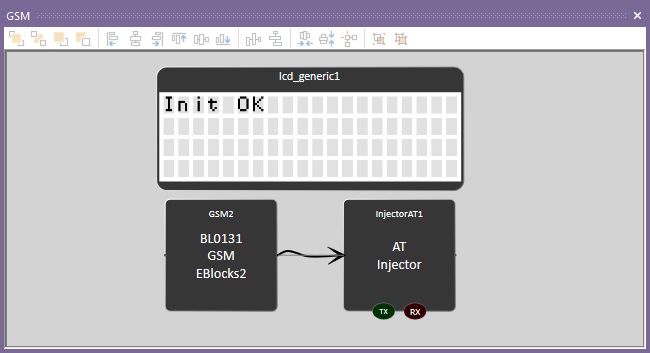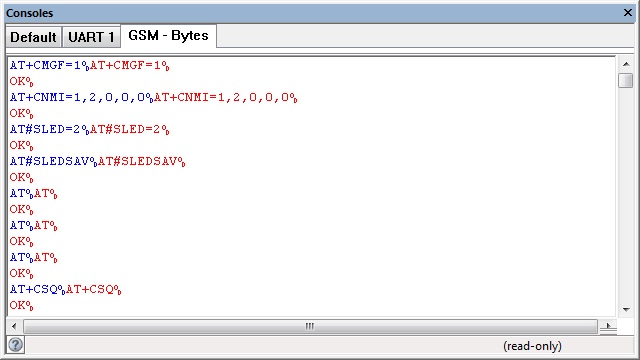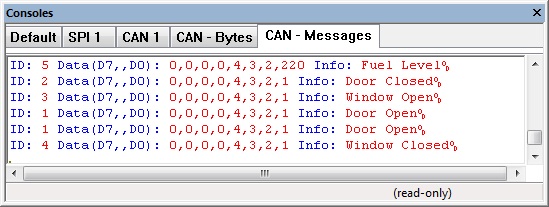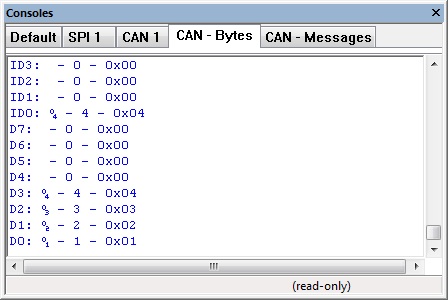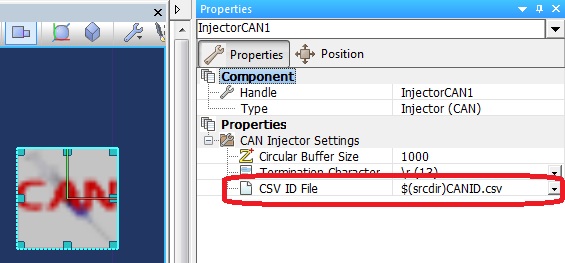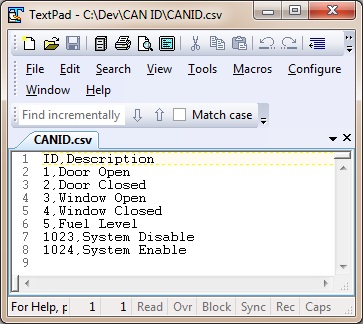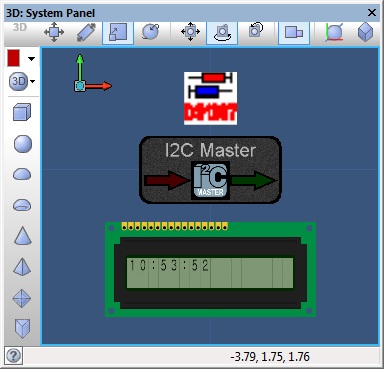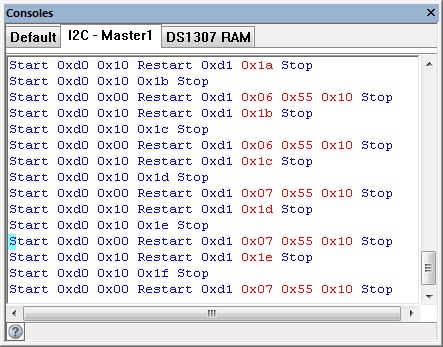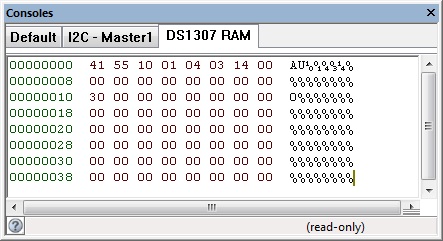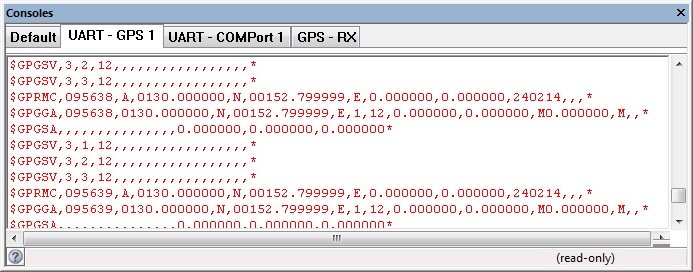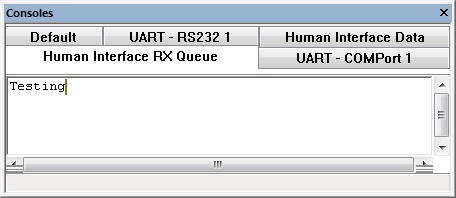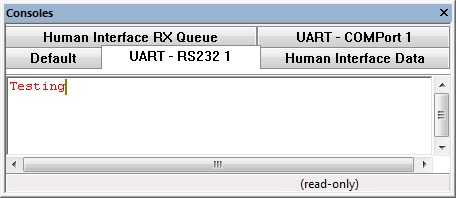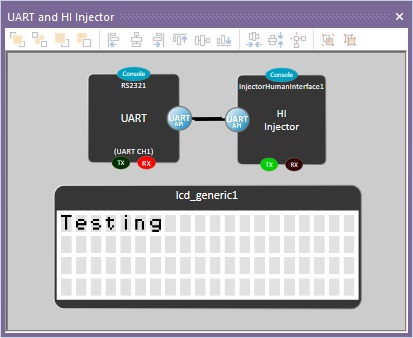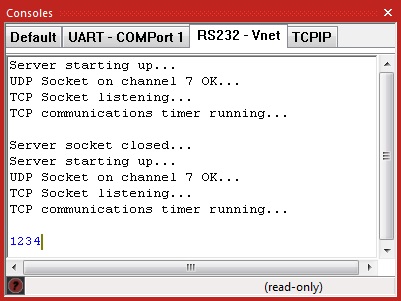Component: Data Injector Template (Comms Data Injectors)
| Author | Matrix Ltd |
| Version | 1.0 |
| Category | Comms Data Injectors |
Contents
Data Injector Template component
A base data injector used as a placeholder in components which reference the data injector interface. Not recommended for use in projects.
Component Source Code
Please click here to download the component source project: FC_Comp_Source_InjectorBase.fcfx
Please click here to view the component source code (Beta): FC_Comp_Source_InjectorBase.fcfx
Detailed description
No detailed description exists yet for this component
Examples
AT Example
GSM Example File
![]() GSM Example
Example should show the following on the display on the panel and on the hardware.
GSM Example
Example should show the following on the display on the panel and on the hardware.
The AT injector component allows us to simulate the response of the GSM module.
CAN Example
The CAN component works together with the injector component to allow you to decode a CAN message ID into a meaningful command.
![]() CAN_Example1
When a key on the keypad is pressed the CAN components transmits a CAN packet.
CAN_Example1
When a key on the keypad is pressed the CAN components transmits a CAN packet.
The CAN packet is decoded by the injector component to give us a meaningful log on the console window.
High Level CAN Data Console
Low Level CAN Data Console
Reference from CAN Injector to ID decode file, $(srcdir) refers to the current project directory.
Demo CAN ID file File:CANID.csv
DS1307 Example
This example uses the I2C master component combined with the DS1307 injector to simulate an I2C communications bus between the target Microcontroller and the virtual DS1307 device.
![]() I2C DS1307 Example
The panel displays the current time from the DS1307 RAM which is populated to match the system time.
I2C DS1307 Example
The panel displays the current time from the DS1307 RAM which is populated to match the system time.
The I2C console shows the communications between the target microcontroller and simulated I2C device.
The DS1307 console shows the contents of RAM memory on the simulated I2C device.
GPS Example
GPS Example File
![]() GPS Example
Example should show the Latitude generated by the GPS injector as well as the system time in simulation or UTC time on hardware.
GPS Example
Example should show the Latitude generated by the GPS injector as well as the system time in simulation or UTC time on hardware.
Example data provided by the GPS NMEA injector component
Human Interface Example
This example receives a character via the RS232 component and outputs it to the LCD, an injector has been added to allow you to type data into the console.
![]() Human Interface Injector Example
The Console window has tabs for the human interface data injector allowing you to type in data that will be received by the component.
Human Interface Injector Example
The Console window has tabs for the human interface data injector allowing you to type in data that will be received by the component.
Again the RS232 console tabs reflect the data as it is sent and received.
LCD showing received data.
vNet Example
Here is an example of using the vNet injector to simulate a multi microcontroller system.
Microcontroller 1 is connected to a keypad and has a RS232 communications connection.
Microcontroller 2 is connected to a solenoid and has a RS232 communications connection.
Any key presses detected on microcontroller 1 will be sent via RS232 to microcontroller 2. If the correct byte sequence (1234) is received by microcontroller 2 then the solenoid is fired to unlock a door for 5 seconds.
![]() vNet Example Node 1
vNet Example Node 1
![]() vNet Example Node 2
Communications over the vNet injector can be monitored using the console.
vNet Example Node 2
Communications over the vNet injector can be monitored using the console.
SCADA Slave Example
Using one of the SCADA Slave components together with one of the SCADA Slave injectors allows simulated comms data to be piped through to real world hardware. This allows for rapid prototyping and testing without the pains of repeated compilation and programming. This feature can be used with any component that contains SPI, I2C or UART based comms (depending on the hardware).
Here is an example using the Arduino Uno as the host board. The Arduino has been pre-programmed with the SCADA Slave firmware available from the Component: SCADA (Arduino Uno) (SCADA Slaves)
Creating New Injector Components
Here are some example Injector component source files which go a good way towards demonstrating how to create your own injector component.
DS1307 I2C Device Example Injector Source
AT Device Example Injector Source
More information is available here: Matrix Flowcode Blog: Flowcode and Injector Components
Macro reference
ChangeState
GetRxConsoleHandle
| GetRxConsoleHandle | |
| Gets the handle to the console allowing data displaying on the panel etc. | |
| Return | |
GetTxConsoleHandle
| GetTxConsoleHandle | |
| Gets the handle to the console allowing data displaying on the panel etc. | |
| Return | |
InitialiseInjector
| InitialiseInjector | |
| InjectorName | |
| Return | |
RxByte
| RxByte | |
| Attempt to receive a byte back from the injector 0 - 255 = Valid data 256 = RX timeout no data available | |
| Return | |
RxByteCount
| RxByteCount | |
| Returns the number of bytes currently sat in the receive buffer. | |
| Return | |
TxByte
| TxByte | |
| Transmit a byte out to the Injector | |
| Data | |
| Return | |
Property reference
| Properties | |
| Circular Buffer Size | |
